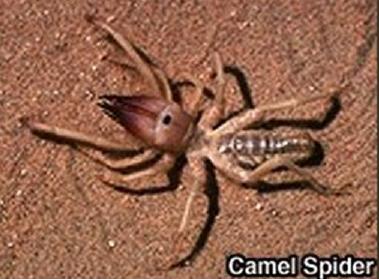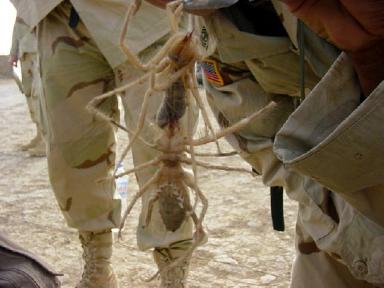Claim: Photograph shows camel spiders found in Iraq.
Example: [Collected on the Internet, 2004]
Origins: The photo displayed above does indeed show camel spiders encountered in Iraq, but a number of the claims about them multi-legged creatures made in accompanying text are inaccurate or exaggerated.

Claims of camel spiders being flesh-eating anesthesia-injecting beasts are folklore, not reality, so worry not that those serving in our country's armed forces in Iraq are having to deal with man-eating creepy-crawlies the size of small cats.
Camel spiders, also known as wind spiders, wind scorpions, and sun scorpions, are a type of arthropod found (among other places) in the deserts of the Middle East. They're technically not spiders but solifugae (although, like spiders, they belong to the class Arachnida). Camel spiders are the subject of a variety of legendary claims, many of them familiar to Americans because they were spread by U.S. servicemen who served in the Persian Gulf War in 1991, and
- Camel spiders can grow to be as large as dinner plates.
- Camel spiders can traverse desert sand at speeds up to
25 MPH , making screaming noises as they run. - Camel spiders can jump several feet in the air.
- Camel spiders eat the stomachs of camels and lay their eggs there, hence the name "camel spider." (Legend includes the detail that camel spiders eat camel stomachs from either the outside in or the inside out. In the former case they supposedly jump up from the ground and grab onto camels' bellies from underneath; in the latter case exactly how spiders allegedly as large as dinner plates get into camels' stomachs intact remains unexplained.)
- Camel spiders are venomous, and their venom contains a powerful anesthetic that numbs their victims (thus allowing them to gnaw away at living, immobilized animals without being noticed).
U.S. soldiers were said to have been attacked by camel spiders at night but remained completely unaware of their plight until they awakened in the morning to find chunks of their flesh missing.
These claims are all false. Camel spiders (so named because, like camels, they can be found in sandy desert regions, although they aren't technically spiders) grow to be moderately large (about a
Although the creatures shown in the photograph above appear to be far too big for camel spiders, they look misleadingly large because of their closeness to the camera, which creates an illusion of exaggerated size. (Note their size in comparison to the uniform sleeve which appears in upper right-hand portion of the picture.)
| | Camel Spiders: Behind an E-Mail Sensation from Iraq (National Geographic) |
| | Camel Spider Caresheet (Fauna Import UK) |
Last updated: 29 May 2005
 Sources:
Sources:

